University Healthcare Assignment: Chronic Condition Care Analysis
VerifiedAdded on 2023/01/03
|10
|3111
|78
Report
AI Summary
This healthcare assignment analyzes the case of a 55-year-old Indigenous woman with a chronic condition, likely Type II Diabetes, living in the South Western Sydney Local Health District. The report identifies lifestyle factors like smoking, unhealthy diet, and weight gain as potential triggers. It explores the Australian healthcare system's capacity to manage chronic illnesses, highlighting the role of multidisciplinary teams and resources like Health Pathways. The assignment emphasizes a patient-centered approach, including referrals to nutritionists, community nurses, and physiotherapists, alongside family-centered practices. It discusses the importance of addressing the patient's cultural and spiritual preferences, mental health, and financial considerations to ensure holistic care and improve health outcomes. The report also includes a focus on medication management, exercise routines, and the use of support programs to ensure the patient's well-being.
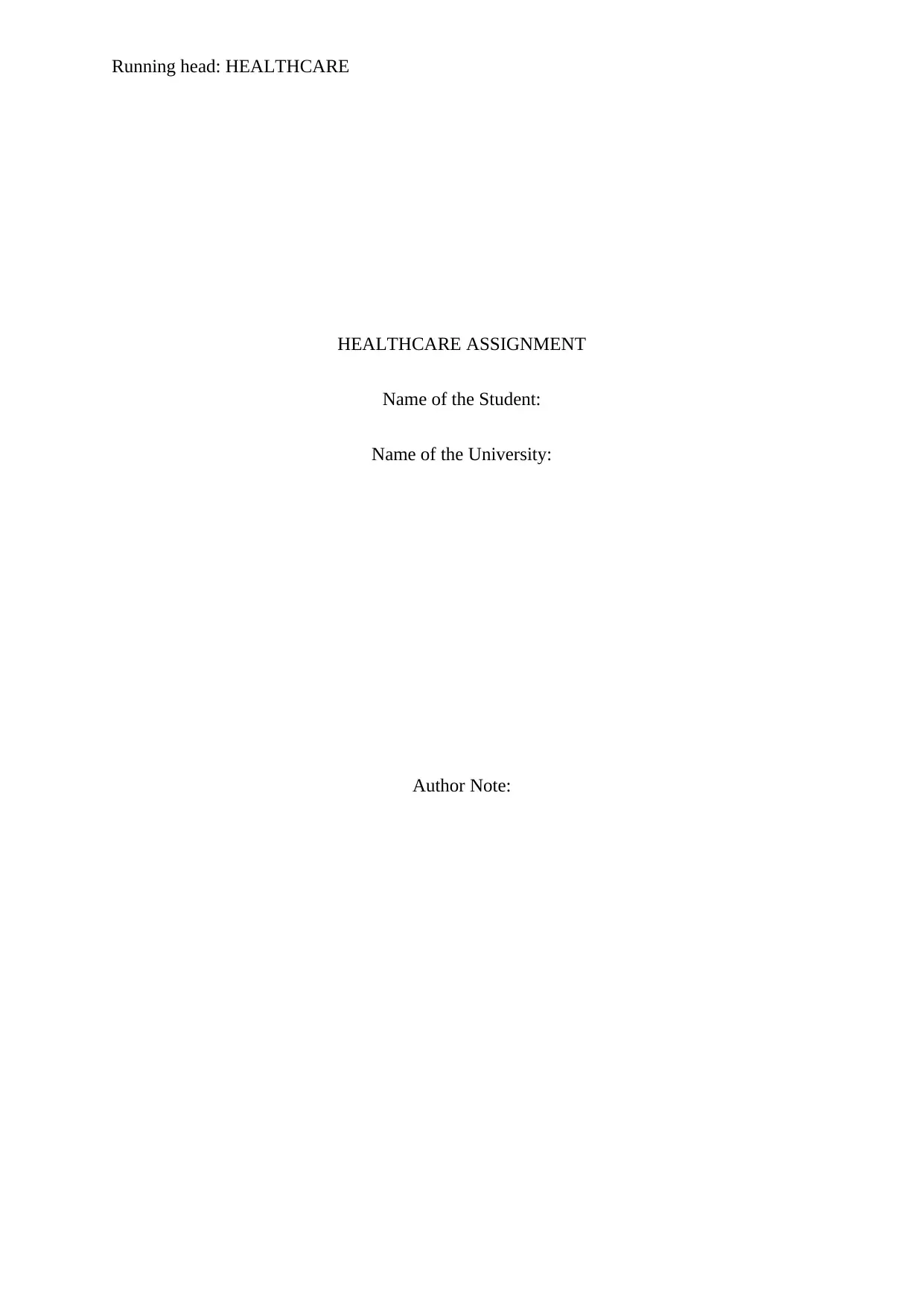
Running head: HEALTHCARE
HEALTHCARE ASSIGNMENT
Name of the Student:
Name of the University:
Author Note:
HEALTHCARE ASSIGNMENT
Name of the Student:
Name of the University:
Author Note:
Paraphrase This Document
Need a fresh take? Get an instant paraphrase of this document with our AI Paraphraser
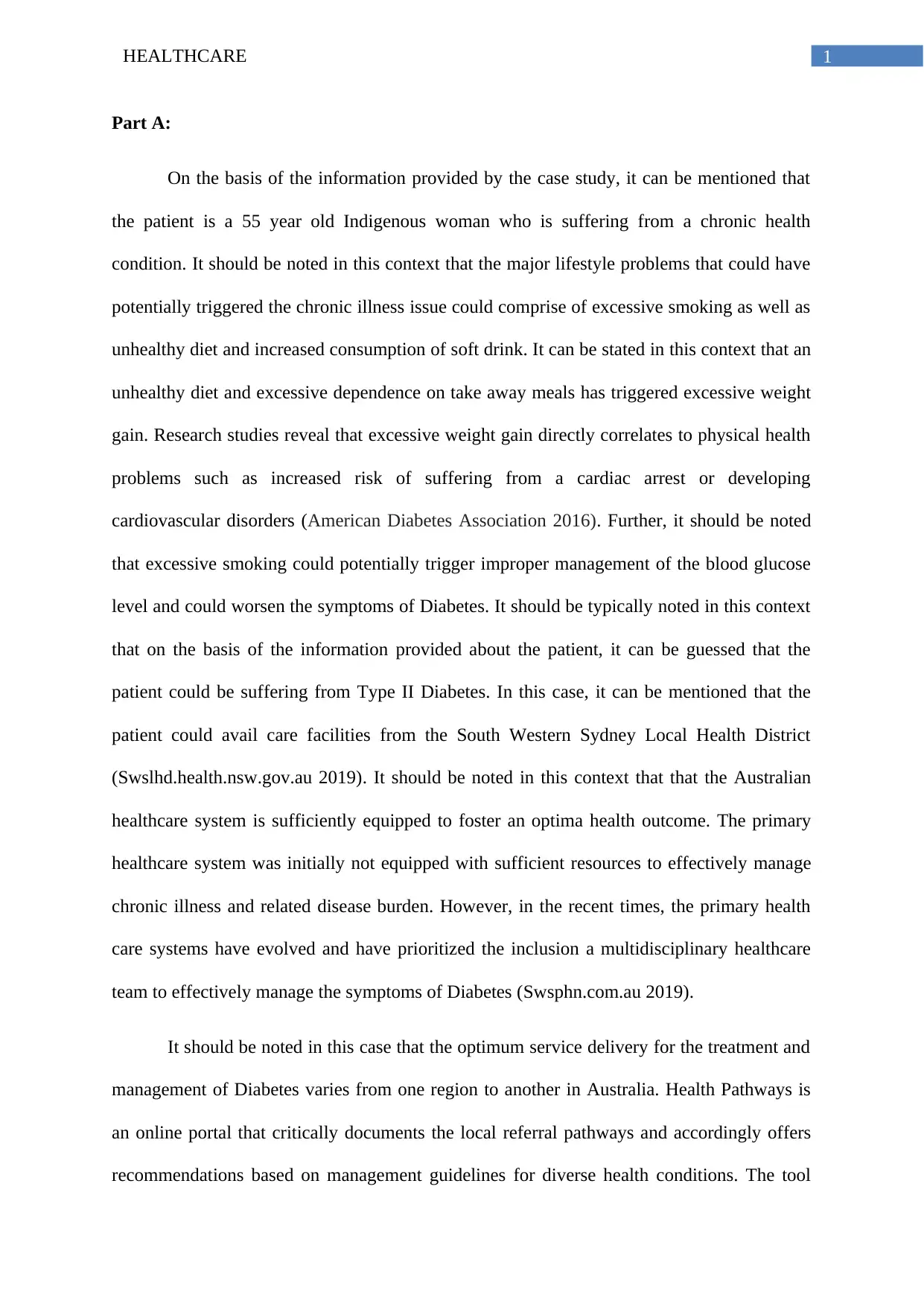
1HEALTHCARE
Part A:
On the basis of the information provided by the case study, it can be mentioned that
the patient is a 55 year old Indigenous woman who is suffering from a chronic health
condition. It should be noted in this context that the major lifestyle problems that could have
potentially triggered the chronic illness issue could comprise of excessive smoking as well as
unhealthy diet and increased consumption of soft drink. It can be stated in this context that an
unhealthy diet and excessive dependence on take away meals has triggered excessive weight
gain. Research studies reveal that excessive weight gain directly correlates to physical health
problems such as increased risk of suffering from a cardiac arrest or developing
cardiovascular disorders (American Diabetes Association 2016). Further, it should be noted
that excessive smoking could potentially trigger improper management of the blood glucose
level and could worsen the symptoms of Diabetes. It should be typically noted in this context
that on the basis of the information provided about the patient, it can be guessed that the
patient could be suffering from Type II Diabetes. In this case, it can be mentioned that the
patient could avail care facilities from the South Western Sydney Local Health District
(Swslhd.health.nsw.gov.au 2019). It should be noted in this context that that the Australian
healthcare system is sufficiently equipped to foster an optima health outcome. The primary
healthcare system was initially not equipped with sufficient resources to effectively manage
chronic illness and related disease burden. However, in the recent times, the primary health
care systems have evolved and have prioritized the inclusion a multidisciplinary healthcare
team to effectively manage the symptoms of Diabetes (Swsphn.com.au 2019).
It should be noted in this case that the optimum service delivery for the treatment and
management of Diabetes varies from one region to another in Australia. Health Pathways is
an online portal that critically documents the local referral pathways and accordingly offers
recommendations based on management guidelines for diverse health conditions. The tool
Part A:
On the basis of the information provided by the case study, it can be mentioned that
the patient is a 55 year old Indigenous woman who is suffering from a chronic health
condition. It should be noted in this context that the major lifestyle problems that could have
potentially triggered the chronic illness issue could comprise of excessive smoking as well as
unhealthy diet and increased consumption of soft drink. It can be stated in this context that an
unhealthy diet and excessive dependence on take away meals has triggered excessive weight
gain. Research studies reveal that excessive weight gain directly correlates to physical health
problems such as increased risk of suffering from a cardiac arrest or developing
cardiovascular disorders (American Diabetes Association 2016). Further, it should be noted
that excessive smoking could potentially trigger improper management of the blood glucose
level and could worsen the symptoms of Diabetes. It should be typically noted in this context
that on the basis of the information provided about the patient, it can be guessed that the
patient could be suffering from Type II Diabetes. In this case, it can be mentioned that the
patient could avail care facilities from the South Western Sydney Local Health District
(Swslhd.health.nsw.gov.au 2019). It should be noted in this context that that the Australian
healthcare system is sufficiently equipped to foster an optima health outcome. The primary
healthcare system was initially not equipped with sufficient resources to effectively manage
chronic illness and related disease burden. However, in the recent times, the primary health
care systems have evolved and have prioritized the inclusion a multidisciplinary healthcare
team to effectively manage the symptoms of Diabetes (Swsphn.com.au 2019).
It should be noted in this case that the optimum service delivery for the treatment and
management of Diabetes varies from one region to another in Australia. Health Pathways is
an online portal that critically documents the local referral pathways and accordingly offers
recommendations based on management guidelines for diverse health conditions. The tool
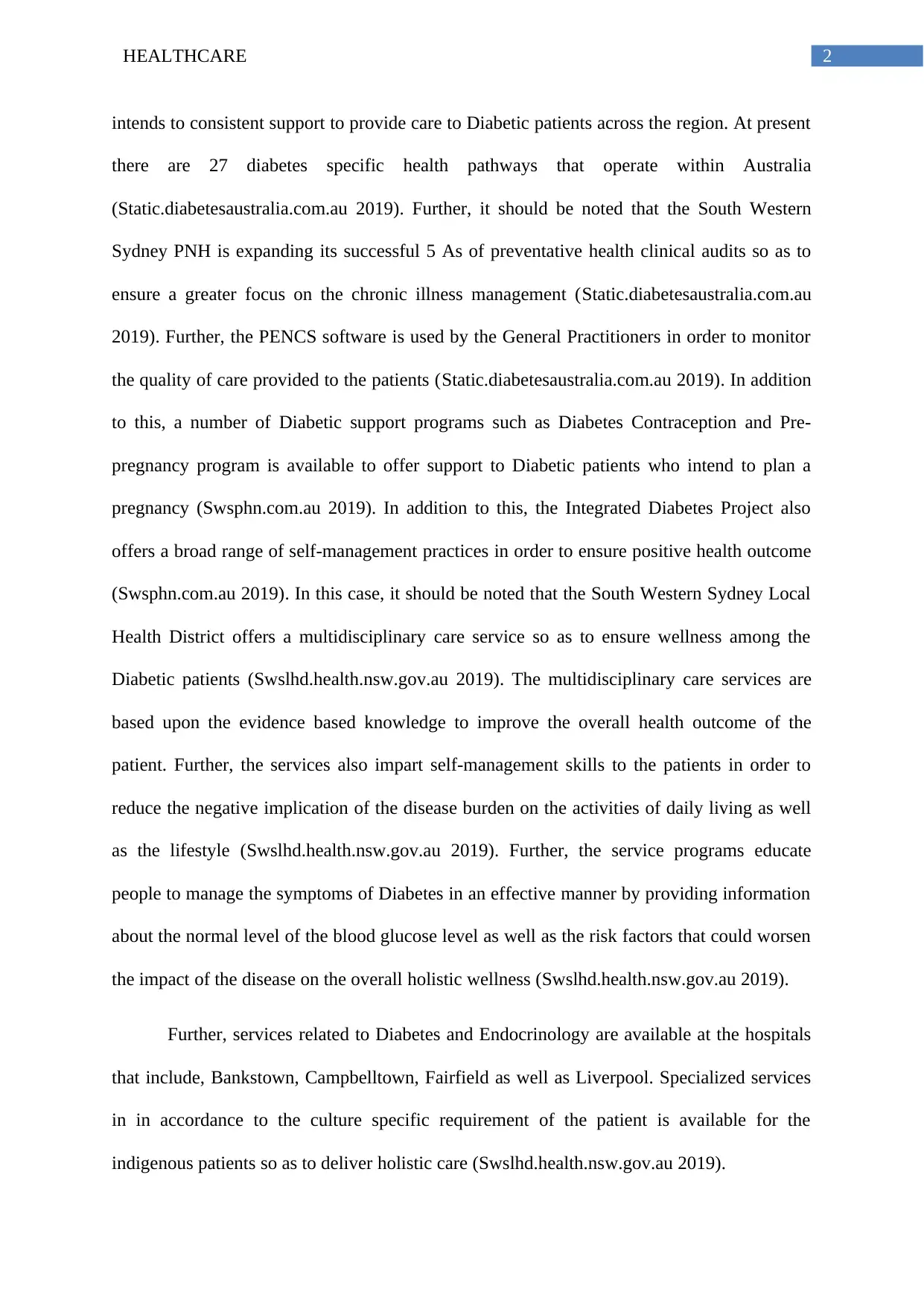
2HEALTHCARE
intends to consistent support to provide care to Diabetic patients across the region. At present
there are 27 diabetes specific health pathways that operate within Australia
(Static.diabetesaustralia.com.au 2019). Further, it should be noted that the South Western
Sydney PNH is expanding its successful 5 As of preventative health clinical audits so as to
ensure a greater focus on the chronic illness management (Static.diabetesaustralia.com.au
2019). Further, the PENCS software is used by the General Practitioners in order to monitor
the quality of care provided to the patients (Static.diabetesaustralia.com.au 2019). In addition
to this, a number of Diabetic support programs such as Diabetes Contraception and Pre-
pregnancy program is available to offer support to Diabetic patients who intend to plan a
pregnancy (Swsphn.com.au 2019). In addition to this, the Integrated Diabetes Project also
offers a broad range of self-management practices in order to ensure positive health outcome
(Swsphn.com.au 2019). In this case, it should be noted that the South Western Sydney Local
Health District offers a multidisciplinary care service so as to ensure wellness among the
Diabetic patients (Swslhd.health.nsw.gov.au 2019). The multidisciplinary care services are
based upon the evidence based knowledge to improve the overall health outcome of the
patient. Further, the services also impart self-management skills to the patients in order to
reduce the negative implication of the disease burden on the activities of daily living as well
as the lifestyle (Swslhd.health.nsw.gov.au 2019). Further, the service programs educate
people to manage the symptoms of Diabetes in an effective manner by providing information
about the normal level of the blood glucose level as well as the risk factors that could worsen
the impact of the disease on the overall holistic wellness (Swslhd.health.nsw.gov.au 2019).
Further, services related to Diabetes and Endocrinology are available at the hospitals
that include, Bankstown, Campbelltown, Fairfield as well as Liverpool. Specialized services
in in accordance to the culture specific requirement of the patient is available for the
indigenous patients so as to deliver holistic care (Swslhd.health.nsw.gov.au 2019).
intends to consistent support to provide care to Diabetic patients across the region. At present
there are 27 diabetes specific health pathways that operate within Australia
(Static.diabetesaustralia.com.au 2019). Further, it should be noted that the South Western
Sydney PNH is expanding its successful 5 As of preventative health clinical audits so as to
ensure a greater focus on the chronic illness management (Static.diabetesaustralia.com.au
2019). Further, the PENCS software is used by the General Practitioners in order to monitor
the quality of care provided to the patients (Static.diabetesaustralia.com.au 2019). In addition
to this, a number of Diabetic support programs such as Diabetes Contraception and Pre-
pregnancy program is available to offer support to Diabetic patients who intend to plan a
pregnancy (Swsphn.com.au 2019). In addition to this, the Integrated Diabetes Project also
offers a broad range of self-management practices in order to ensure positive health outcome
(Swsphn.com.au 2019). In this case, it should be noted that the South Western Sydney Local
Health District offers a multidisciplinary care service so as to ensure wellness among the
Diabetic patients (Swslhd.health.nsw.gov.au 2019). The multidisciplinary care services are
based upon the evidence based knowledge to improve the overall health outcome of the
patient. Further, the services also impart self-management skills to the patients in order to
reduce the negative implication of the disease burden on the activities of daily living as well
as the lifestyle (Swslhd.health.nsw.gov.au 2019). Further, the service programs educate
people to manage the symptoms of Diabetes in an effective manner by providing information
about the normal level of the blood glucose level as well as the risk factors that could worsen
the impact of the disease on the overall holistic wellness (Swslhd.health.nsw.gov.au 2019).
Further, services related to Diabetes and Endocrinology are available at the hospitals
that include, Bankstown, Campbelltown, Fairfield as well as Liverpool. Specialized services
in in accordance to the culture specific requirement of the patient is available for the
indigenous patients so as to deliver holistic care (Swslhd.health.nsw.gov.au 2019).
⊘ This is a preview!⊘
Do you want full access?
Subscribe today to unlock all pages.

Trusted by 1+ million students worldwide
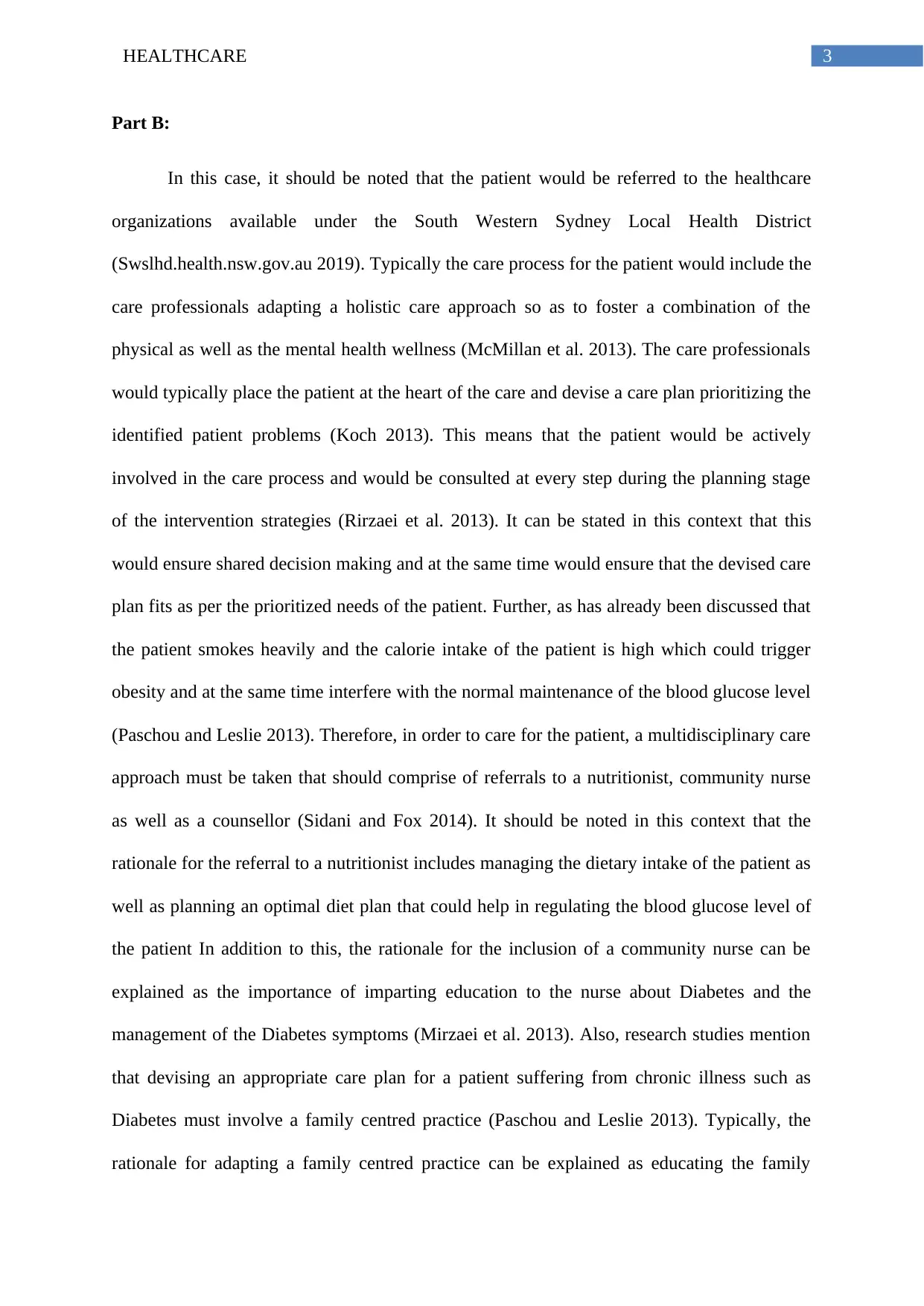
3HEALTHCARE
Part B:
In this case, it should be noted that the patient would be referred to the healthcare
organizations available under the South Western Sydney Local Health District
(Swslhd.health.nsw.gov.au 2019). Typically the care process for the patient would include the
care professionals adapting a holistic care approach so as to foster a combination of the
physical as well as the mental health wellness (McMillan et al. 2013). The care professionals
would typically place the patient at the heart of the care and devise a care plan prioritizing the
identified patient problems (Koch 2013). This means that the patient would be actively
involved in the care process and would be consulted at every step during the planning stage
of the intervention strategies (Rirzaei et al. 2013). It can be stated in this context that this
would ensure shared decision making and at the same time would ensure that the devised care
plan fits as per the prioritized needs of the patient. Further, as has already been discussed that
the patient smokes heavily and the calorie intake of the patient is high which could trigger
obesity and at the same time interfere with the normal maintenance of the blood glucose level
(Paschou and Leslie 2013). Therefore, in order to care for the patient, a multidisciplinary care
approach must be taken that should comprise of referrals to a nutritionist, community nurse
as well as a counsellor (Sidani and Fox 2014). It should be noted in this context that the
rationale for the referral to a nutritionist includes managing the dietary intake of the patient as
well as planning an optimal diet plan that could help in regulating the blood glucose level of
the patient In addition to this, the rationale for the inclusion of a community nurse can be
explained as the importance of imparting education to the nurse about Diabetes and the
management of the Diabetes symptoms (Mirzaei et al. 2013). Also, research studies mention
that devising an appropriate care plan for a patient suffering from chronic illness such as
Diabetes must involve a family centred practice (Paschou and Leslie 2013). Typically, the
rationale for adapting a family centred practice can be explained as educating the family
Part B:
In this case, it should be noted that the patient would be referred to the healthcare
organizations available under the South Western Sydney Local Health District
(Swslhd.health.nsw.gov.au 2019). Typically the care process for the patient would include the
care professionals adapting a holistic care approach so as to foster a combination of the
physical as well as the mental health wellness (McMillan et al. 2013). The care professionals
would typically place the patient at the heart of the care and devise a care plan prioritizing the
identified patient problems (Koch 2013). This means that the patient would be actively
involved in the care process and would be consulted at every step during the planning stage
of the intervention strategies (Rirzaei et al. 2013). It can be stated in this context that this
would ensure shared decision making and at the same time would ensure that the devised care
plan fits as per the prioritized needs of the patient. Further, as has already been discussed that
the patient smokes heavily and the calorie intake of the patient is high which could trigger
obesity and at the same time interfere with the normal maintenance of the blood glucose level
(Paschou and Leslie 2013). Therefore, in order to care for the patient, a multidisciplinary care
approach must be taken that should comprise of referrals to a nutritionist, community nurse
as well as a counsellor (Sidani and Fox 2014). It should be noted in this context that the
rationale for the referral to a nutritionist includes managing the dietary intake of the patient as
well as planning an optimal diet plan that could help in regulating the blood glucose level of
the patient In addition to this, the rationale for the inclusion of a community nurse can be
explained as the importance of imparting education to the nurse about Diabetes and the
management of the Diabetes symptoms (Mirzaei et al. 2013). Also, research studies mention
that devising an appropriate care plan for a patient suffering from chronic illness such as
Diabetes must involve a family centred practice (Paschou and Leslie 2013). Typically, the
rationale for adapting a family centred practice can be explained as educating the family
Paraphrase This Document
Need a fresh take? Get an instant paraphrase of this document with our AI Paraphraser
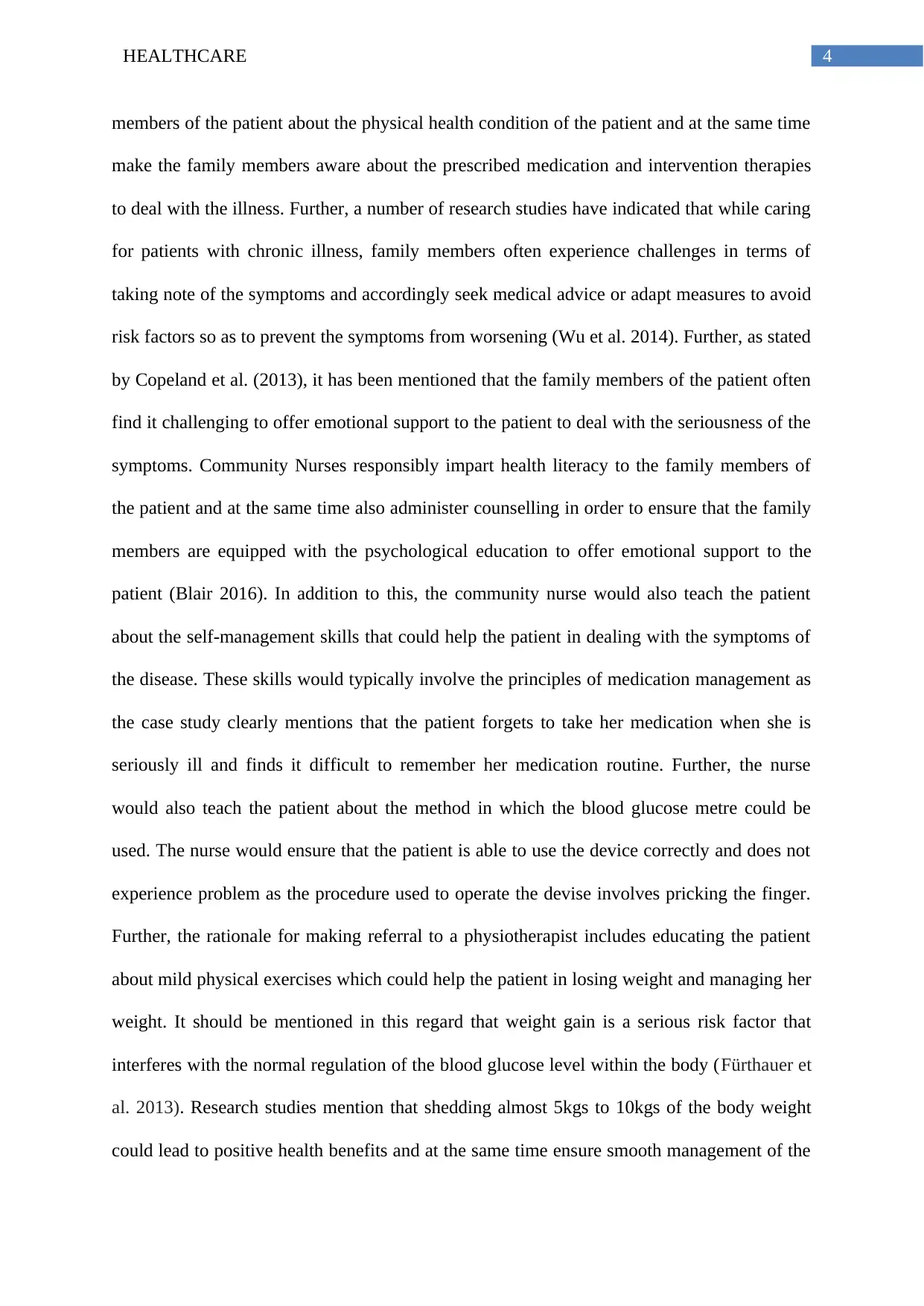
4HEALTHCARE
members of the patient about the physical health condition of the patient and at the same time
make the family members aware about the prescribed medication and intervention therapies
to deal with the illness. Further, a number of research studies have indicated that while caring
for patients with chronic illness, family members often experience challenges in terms of
taking note of the symptoms and accordingly seek medical advice or adapt measures to avoid
risk factors so as to prevent the symptoms from worsening (Wu et al. 2014). Further, as stated
by Copeland et al. (2013), it has been mentioned that the family members of the patient often
find it challenging to offer emotional support to the patient to deal with the seriousness of the
symptoms. Community Nurses responsibly impart health literacy to the family members of
the patient and at the same time also administer counselling in order to ensure that the family
members are equipped with the psychological education to offer emotional support to the
patient (Blair 2016). In addition to this, the community nurse would also teach the patient
about the self-management skills that could help the patient in dealing with the symptoms of
the disease. These skills would typically involve the principles of medication management as
the case study clearly mentions that the patient forgets to take her medication when she is
seriously ill and finds it difficult to remember her medication routine. Further, the nurse
would also teach the patient about the method in which the blood glucose metre could be
used. The nurse would ensure that the patient is able to use the device correctly and does not
experience problem as the procedure used to operate the devise involves pricking the finger.
Further, the rationale for making referral to a physiotherapist includes educating the patient
about mild physical exercises which could help the patient in losing weight and managing her
weight. It should be mentioned in this regard that weight gain is a serious risk factor that
interferes with the normal regulation of the blood glucose level within the body (Fürthauer et
al. 2013). Research studies mention that shedding almost 5kgs to 10kgs of the body weight
could lead to positive health benefits and at the same time ensure smooth management of the
members of the patient about the physical health condition of the patient and at the same time
make the family members aware about the prescribed medication and intervention therapies
to deal with the illness. Further, a number of research studies have indicated that while caring
for patients with chronic illness, family members often experience challenges in terms of
taking note of the symptoms and accordingly seek medical advice or adapt measures to avoid
risk factors so as to prevent the symptoms from worsening (Wu et al. 2014). Further, as stated
by Copeland et al. (2013), it has been mentioned that the family members of the patient often
find it challenging to offer emotional support to the patient to deal with the seriousness of the
symptoms. Community Nurses responsibly impart health literacy to the family members of
the patient and at the same time also administer counselling in order to ensure that the family
members are equipped with the psychological education to offer emotional support to the
patient (Blair 2016). In addition to this, the community nurse would also teach the patient
about the self-management skills that could help the patient in dealing with the symptoms of
the disease. These skills would typically involve the principles of medication management as
the case study clearly mentions that the patient forgets to take her medication when she is
seriously ill and finds it difficult to remember her medication routine. Further, the nurse
would also teach the patient about the method in which the blood glucose metre could be
used. The nurse would ensure that the patient is able to use the device correctly and does not
experience problem as the procedure used to operate the devise involves pricking the finger.
Further, the rationale for making referral to a physiotherapist includes educating the patient
about mild physical exercises which could help the patient in losing weight and managing her
weight. It should be mentioned in this regard that weight gain is a serious risk factor that
interferes with the normal regulation of the blood glucose level within the body (Fürthauer et
al. 2013). Research studies mention that shedding almost 5kgs to 10kgs of the body weight
could lead to positive health benefits and at the same time ensure smooth management of the
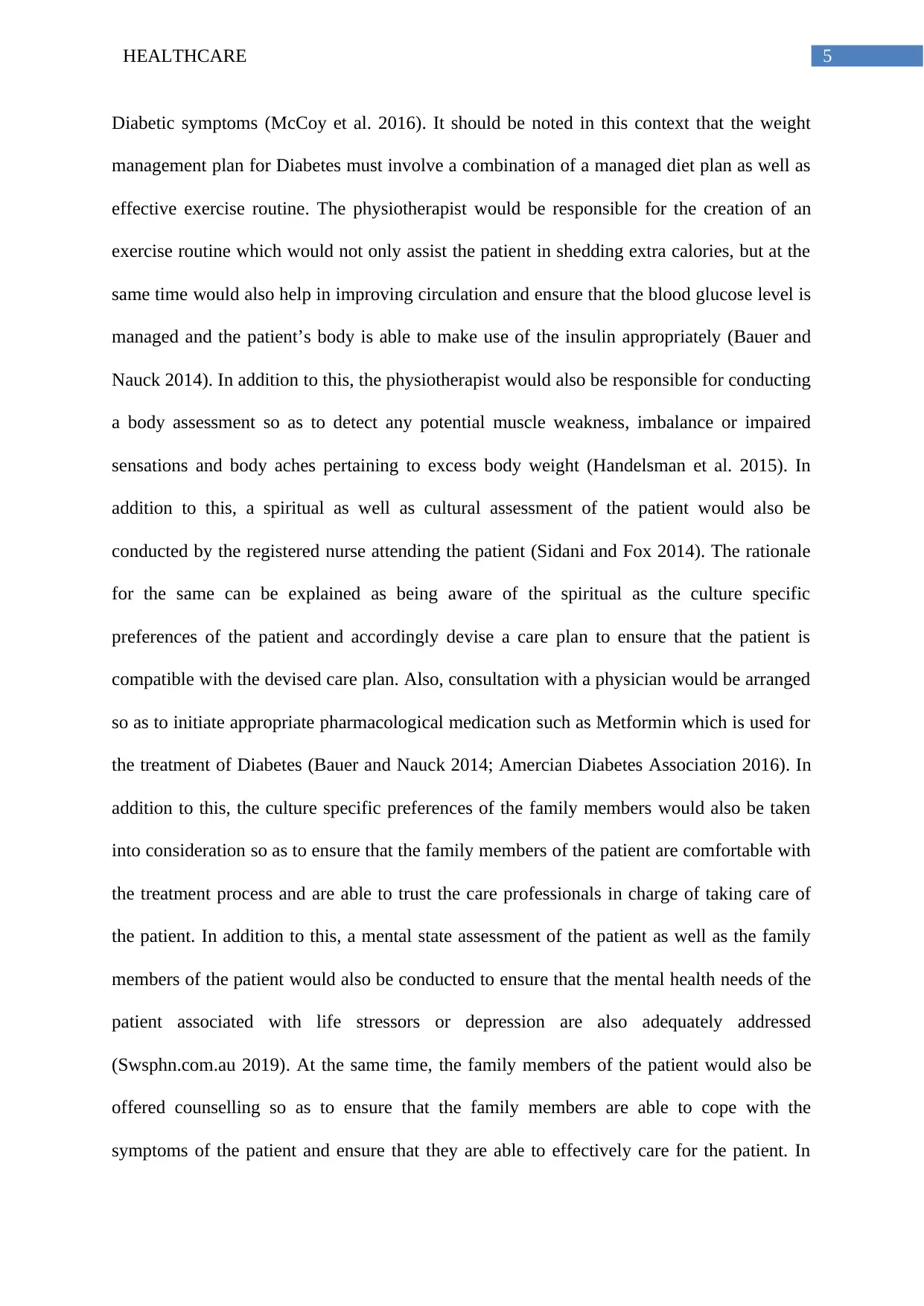
5HEALTHCARE
Diabetic symptoms (McCoy et al. 2016). It should be noted in this context that the weight
management plan for Diabetes must involve a combination of a managed diet plan as well as
effective exercise routine. The physiotherapist would be responsible for the creation of an
exercise routine which would not only assist the patient in shedding extra calories, but at the
same time would also help in improving circulation and ensure that the blood glucose level is
managed and the patient’s body is able to make use of the insulin appropriately (Bauer and
Nauck 2014). In addition to this, the physiotherapist would also be responsible for conducting
a body assessment so as to detect any potential muscle weakness, imbalance or impaired
sensations and body aches pertaining to excess body weight (Handelsman et al. 2015). In
addition to this, a spiritual as well as cultural assessment of the patient would also be
conducted by the registered nurse attending the patient (Sidani and Fox 2014). The rationale
for the same can be explained as being aware of the spiritual as the culture specific
preferences of the patient and accordingly devise a care plan to ensure that the patient is
compatible with the devised care plan. Also, consultation with a physician would be arranged
so as to initiate appropriate pharmacological medication such as Metformin which is used for
the treatment of Diabetes (Bauer and Nauck 2014; Amercian Diabetes Association 2016). In
addition to this, the culture specific preferences of the family members would also be taken
into consideration so as to ensure that the family members of the patient are comfortable with
the treatment process and are able to trust the care professionals in charge of taking care of
the patient. In addition to this, a mental state assessment of the patient as well as the family
members of the patient would also be conducted to ensure that the mental health needs of the
patient associated with life stressors or depression are also adequately addressed
(Swsphn.com.au 2019). At the same time, the family members of the patient would also be
offered counselling so as to ensure that the family members are able to cope with the
symptoms of the patient and ensure that they are able to effectively care for the patient. In
Diabetic symptoms (McCoy et al. 2016). It should be noted in this context that the weight
management plan for Diabetes must involve a combination of a managed diet plan as well as
effective exercise routine. The physiotherapist would be responsible for the creation of an
exercise routine which would not only assist the patient in shedding extra calories, but at the
same time would also help in improving circulation and ensure that the blood glucose level is
managed and the patient’s body is able to make use of the insulin appropriately (Bauer and
Nauck 2014). In addition to this, the physiotherapist would also be responsible for conducting
a body assessment so as to detect any potential muscle weakness, imbalance or impaired
sensations and body aches pertaining to excess body weight (Handelsman et al. 2015). In
addition to this, a spiritual as well as cultural assessment of the patient would also be
conducted by the registered nurse attending the patient (Sidani and Fox 2014). The rationale
for the same can be explained as being aware of the spiritual as the culture specific
preferences of the patient and accordingly devise a care plan to ensure that the patient is
compatible with the devised care plan. Also, consultation with a physician would be arranged
so as to initiate appropriate pharmacological medication such as Metformin which is used for
the treatment of Diabetes (Bauer and Nauck 2014; Amercian Diabetes Association 2016). In
addition to this, the culture specific preferences of the family members would also be taken
into consideration so as to ensure that the family members of the patient are comfortable with
the treatment process and are able to trust the care professionals in charge of taking care of
the patient. In addition to this, a mental state assessment of the patient as well as the family
members of the patient would also be conducted to ensure that the mental health needs of the
patient associated with life stressors or depression are also adequately addressed
(Swsphn.com.au 2019). At the same time, the family members of the patient would also be
offered counselling so as to ensure that the family members are able to cope with the
symptoms of the patient and ensure that they are able to effectively care for the patient. In
⊘ This is a preview!⊘
Do you want full access?
Subscribe today to unlock all pages.

Trusted by 1+ million students worldwide
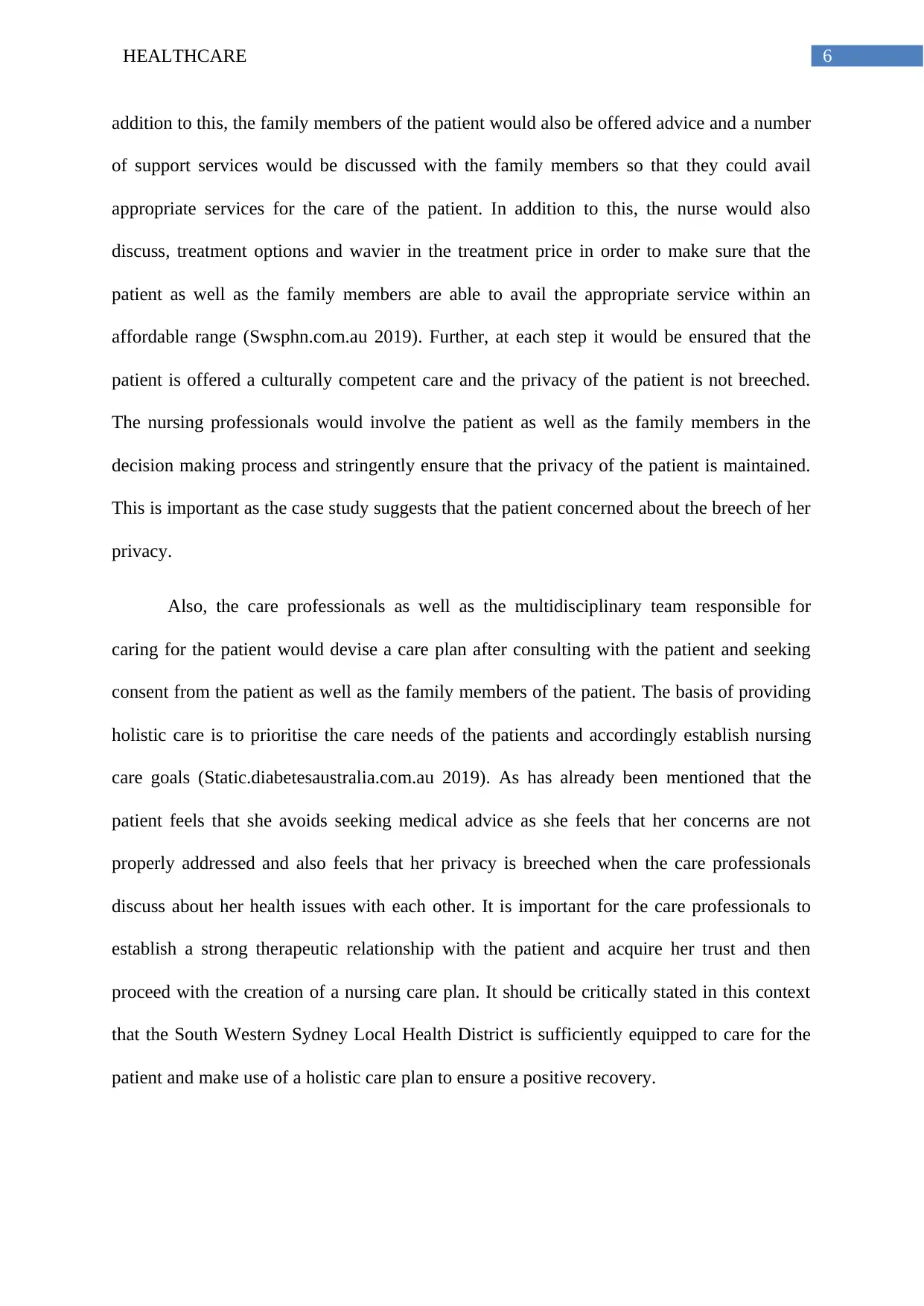
6HEALTHCARE
addition to this, the family members of the patient would also be offered advice and a number
of support services would be discussed with the family members so that they could avail
appropriate services for the care of the patient. In addition to this, the nurse would also
discuss, treatment options and wavier in the treatment price in order to make sure that the
patient as well as the family members are able to avail the appropriate service within an
affordable range (Swsphn.com.au 2019). Further, at each step it would be ensured that the
patient is offered a culturally competent care and the privacy of the patient is not breeched.
The nursing professionals would involve the patient as well as the family members in the
decision making process and stringently ensure that the privacy of the patient is maintained.
This is important as the case study suggests that the patient concerned about the breech of her
privacy.
Also, the care professionals as well as the multidisciplinary team responsible for
caring for the patient would devise a care plan after consulting with the patient and seeking
consent from the patient as well as the family members of the patient. The basis of providing
holistic care is to prioritise the care needs of the patients and accordingly establish nursing
care goals (Static.diabetesaustralia.com.au 2019). As has already been mentioned that the
patient feels that she avoids seeking medical advice as she feels that her concerns are not
properly addressed and also feels that her privacy is breeched when the care professionals
discuss about her health issues with each other. It is important for the care professionals to
establish a strong therapeutic relationship with the patient and acquire her trust and then
proceed with the creation of a nursing care plan. It should be critically stated in this context
that the South Western Sydney Local Health District is sufficiently equipped to care for the
patient and make use of a holistic care plan to ensure a positive recovery.
addition to this, the family members of the patient would also be offered advice and a number
of support services would be discussed with the family members so that they could avail
appropriate services for the care of the patient. In addition to this, the nurse would also
discuss, treatment options and wavier in the treatment price in order to make sure that the
patient as well as the family members are able to avail the appropriate service within an
affordable range (Swsphn.com.au 2019). Further, at each step it would be ensured that the
patient is offered a culturally competent care and the privacy of the patient is not breeched.
The nursing professionals would involve the patient as well as the family members in the
decision making process and stringently ensure that the privacy of the patient is maintained.
This is important as the case study suggests that the patient concerned about the breech of her
privacy.
Also, the care professionals as well as the multidisciplinary team responsible for
caring for the patient would devise a care plan after consulting with the patient and seeking
consent from the patient as well as the family members of the patient. The basis of providing
holistic care is to prioritise the care needs of the patients and accordingly establish nursing
care goals (Static.diabetesaustralia.com.au 2019). As has already been mentioned that the
patient feels that she avoids seeking medical advice as she feels that her concerns are not
properly addressed and also feels that her privacy is breeched when the care professionals
discuss about her health issues with each other. It is important for the care professionals to
establish a strong therapeutic relationship with the patient and acquire her trust and then
proceed with the creation of a nursing care plan. It should be critically stated in this context
that the South Western Sydney Local Health District is sufficiently equipped to care for the
patient and make use of a holistic care plan to ensure a positive recovery.
Paraphrase This Document
Need a fresh take? Get an instant paraphrase of this document with our AI Paraphraser
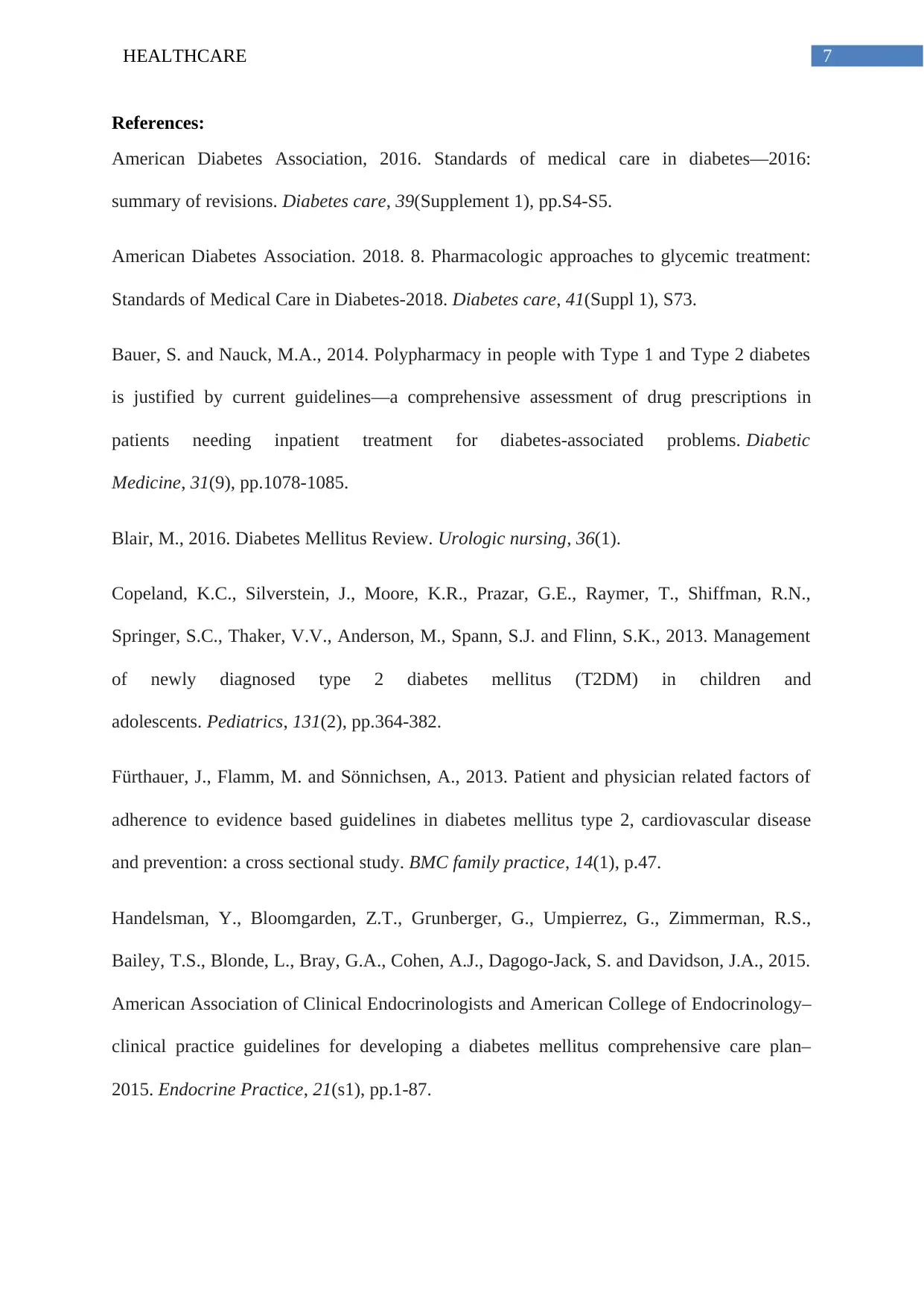
7HEALTHCARE
References:
American Diabetes Association, 2016. Standards of medical care in diabetes—2016:
summary of revisions. Diabetes care, 39(Supplement 1), pp.S4-S5.
American Diabetes Association. 2018. 8. Pharmacologic approaches to glycemic treatment:
Standards of Medical Care in Diabetes-2018. Diabetes care, 41(Suppl 1), S73.
Bauer, S. and Nauck, M.A., 2014. Polypharmacy in people with Type 1 and Type 2 diabetes
is justified by current guidelines—a comprehensive assessment of drug prescriptions in
patients needing inpatient treatment for diabetes‐associated problems. Diabetic
Medicine, 31(9), pp.1078-1085.
Blair, M., 2016. Diabetes Mellitus Review. Urologic nursing, 36(1).
Copeland, K.C., Silverstein, J., Moore, K.R., Prazar, G.E., Raymer, T., Shiffman, R.N.,
Springer, S.C., Thaker, V.V., Anderson, M., Spann, S.J. and Flinn, S.K., 2013. Management
of newly diagnosed type 2 diabetes mellitus (T2DM) in children and
adolescents. Pediatrics, 131(2), pp.364-382.
Fürthauer, J., Flamm, M. and Sönnichsen, A., 2013. Patient and physician related factors of
adherence to evidence based guidelines in diabetes mellitus type 2, cardiovascular disease
and prevention: a cross sectional study. BMC family practice, 14(1), p.47.
Handelsman, Y., Bloomgarden, Z.T., Grunberger, G., Umpierrez, G., Zimmerman, R.S.,
Bailey, T.S., Blonde, L., Bray, G.A., Cohen, A.J., Dagogo-Jack, S. and Davidson, J.A., 2015.
American Association of Clinical Endocrinologists and American College of Endocrinology–
clinical practice guidelines for developing a diabetes mellitus comprehensive care plan–
2015. Endocrine Practice, 21(s1), pp.1-87.
References:
American Diabetes Association, 2016. Standards of medical care in diabetes—2016:
summary of revisions. Diabetes care, 39(Supplement 1), pp.S4-S5.
American Diabetes Association. 2018. 8. Pharmacologic approaches to glycemic treatment:
Standards of Medical Care in Diabetes-2018. Diabetes care, 41(Suppl 1), S73.
Bauer, S. and Nauck, M.A., 2014. Polypharmacy in people with Type 1 and Type 2 diabetes
is justified by current guidelines—a comprehensive assessment of drug prescriptions in
patients needing inpatient treatment for diabetes‐associated problems. Diabetic
Medicine, 31(9), pp.1078-1085.
Blair, M., 2016. Diabetes Mellitus Review. Urologic nursing, 36(1).
Copeland, K.C., Silverstein, J., Moore, K.R., Prazar, G.E., Raymer, T., Shiffman, R.N.,
Springer, S.C., Thaker, V.V., Anderson, M., Spann, S.J. and Flinn, S.K., 2013. Management
of newly diagnosed type 2 diabetes mellitus (T2DM) in children and
adolescents. Pediatrics, 131(2), pp.364-382.
Fürthauer, J., Flamm, M. and Sönnichsen, A., 2013. Patient and physician related factors of
adherence to evidence based guidelines in diabetes mellitus type 2, cardiovascular disease
and prevention: a cross sectional study. BMC family practice, 14(1), p.47.
Handelsman, Y., Bloomgarden, Z.T., Grunberger, G., Umpierrez, G., Zimmerman, R.S.,
Bailey, T.S., Blonde, L., Bray, G.A., Cohen, A.J., Dagogo-Jack, S. and Davidson, J.A., 2015.
American Association of Clinical Endocrinologists and American College of Endocrinology–
clinical practice guidelines for developing a diabetes mellitus comprehensive care plan–
2015. Endocrine Practice, 21(s1), pp.1-87.
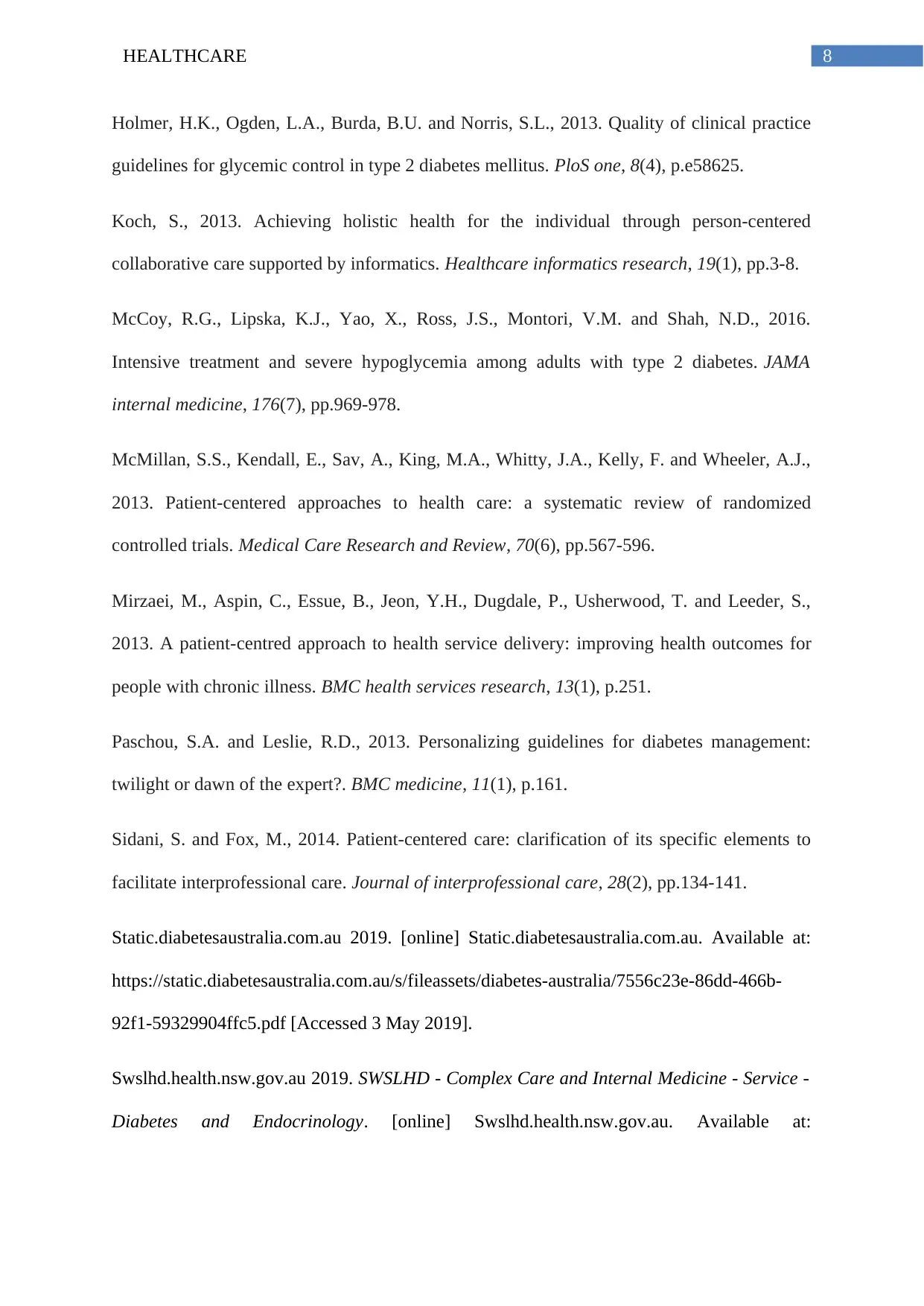
8HEALTHCARE
Holmer, H.K., Ogden, L.A., Burda, B.U. and Norris, S.L., 2013. Quality of clinical practice
guidelines for glycemic control in type 2 diabetes mellitus. PloS one, 8(4), p.e58625.
Koch, S., 2013. Achieving holistic health for the individual through person-centered
collaborative care supported by informatics. Healthcare informatics research, 19(1), pp.3-8.
McCoy, R.G., Lipska, K.J., Yao, X., Ross, J.S., Montori, V.M. and Shah, N.D., 2016.
Intensive treatment and severe hypoglycemia among adults with type 2 diabetes. JAMA
internal medicine, 176(7), pp.969-978.
McMillan, S.S., Kendall, E., Sav, A., King, M.A., Whitty, J.A., Kelly, F. and Wheeler, A.J.,
2013. Patient-centered approaches to health care: a systematic review of randomized
controlled trials. Medical Care Research and Review, 70(6), pp.567-596.
Mirzaei, M., Aspin, C., Essue, B., Jeon, Y.H., Dugdale, P., Usherwood, T. and Leeder, S.,
2013. A patient-centred approach to health service delivery: improving health outcomes for
people with chronic illness. BMC health services research, 13(1), p.251.
Paschou, S.A. and Leslie, R.D., 2013. Personalizing guidelines for diabetes management:
twilight or dawn of the expert?. BMC medicine, 11(1), p.161.
Sidani, S. and Fox, M., 2014. Patient-centered care: clarification of its specific elements to
facilitate interprofessional care. Journal of interprofessional care, 28(2), pp.134-141.
Static.diabetesaustralia.com.au 2019. [online] Static.diabetesaustralia.com.au. Available at:
https://static.diabetesaustralia.com.au/s/fileassets/diabetes-australia/7556c23e-86dd-466b-
92f1-59329904ffc5.pdf [Accessed 3 May 2019].
Swslhd.health.nsw.gov.au 2019. SWSLHD - Complex Care and Internal Medicine - Service -
Diabetes and Endocrinology. [online] Swslhd.health.nsw.gov.au. Available at:
Holmer, H.K., Ogden, L.A., Burda, B.U. and Norris, S.L., 2013. Quality of clinical practice
guidelines for glycemic control in type 2 diabetes mellitus. PloS one, 8(4), p.e58625.
Koch, S., 2013. Achieving holistic health for the individual through person-centered
collaborative care supported by informatics. Healthcare informatics research, 19(1), pp.3-8.
McCoy, R.G., Lipska, K.J., Yao, X., Ross, J.S., Montori, V.M. and Shah, N.D., 2016.
Intensive treatment and severe hypoglycemia among adults with type 2 diabetes. JAMA
internal medicine, 176(7), pp.969-978.
McMillan, S.S., Kendall, E., Sav, A., King, M.A., Whitty, J.A., Kelly, F. and Wheeler, A.J.,
2013. Patient-centered approaches to health care: a systematic review of randomized
controlled trials. Medical Care Research and Review, 70(6), pp.567-596.
Mirzaei, M., Aspin, C., Essue, B., Jeon, Y.H., Dugdale, P., Usherwood, T. and Leeder, S.,
2013. A patient-centred approach to health service delivery: improving health outcomes for
people with chronic illness. BMC health services research, 13(1), p.251.
Paschou, S.A. and Leslie, R.D., 2013. Personalizing guidelines for diabetes management:
twilight or dawn of the expert?. BMC medicine, 11(1), p.161.
Sidani, S. and Fox, M., 2014. Patient-centered care: clarification of its specific elements to
facilitate interprofessional care. Journal of interprofessional care, 28(2), pp.134-141.
Static.diabetesaustralia.com.au 2019. [online] Static.diabetesaustralia.com.au. Available at:
https://static.diabetesaustralia.com.au/s/fileassets/diabetes-australia/7556c23e-86dd-466b-
92f1-59329904ffc5.pdf [Accessed 3 May 2019].
Swslhd.health.nsw.gov.au 2019. SWSLHD - Complex Care and Internal Medicine - Service -
Diabetes and Endocrinology. [online] Swslhd.health.nsw.gov.au. Available at:
⊘ This is a preview!⊘
Do you want full access?
Subscribe today to unlock all pages.

Trusted by 1+ million students worldwide
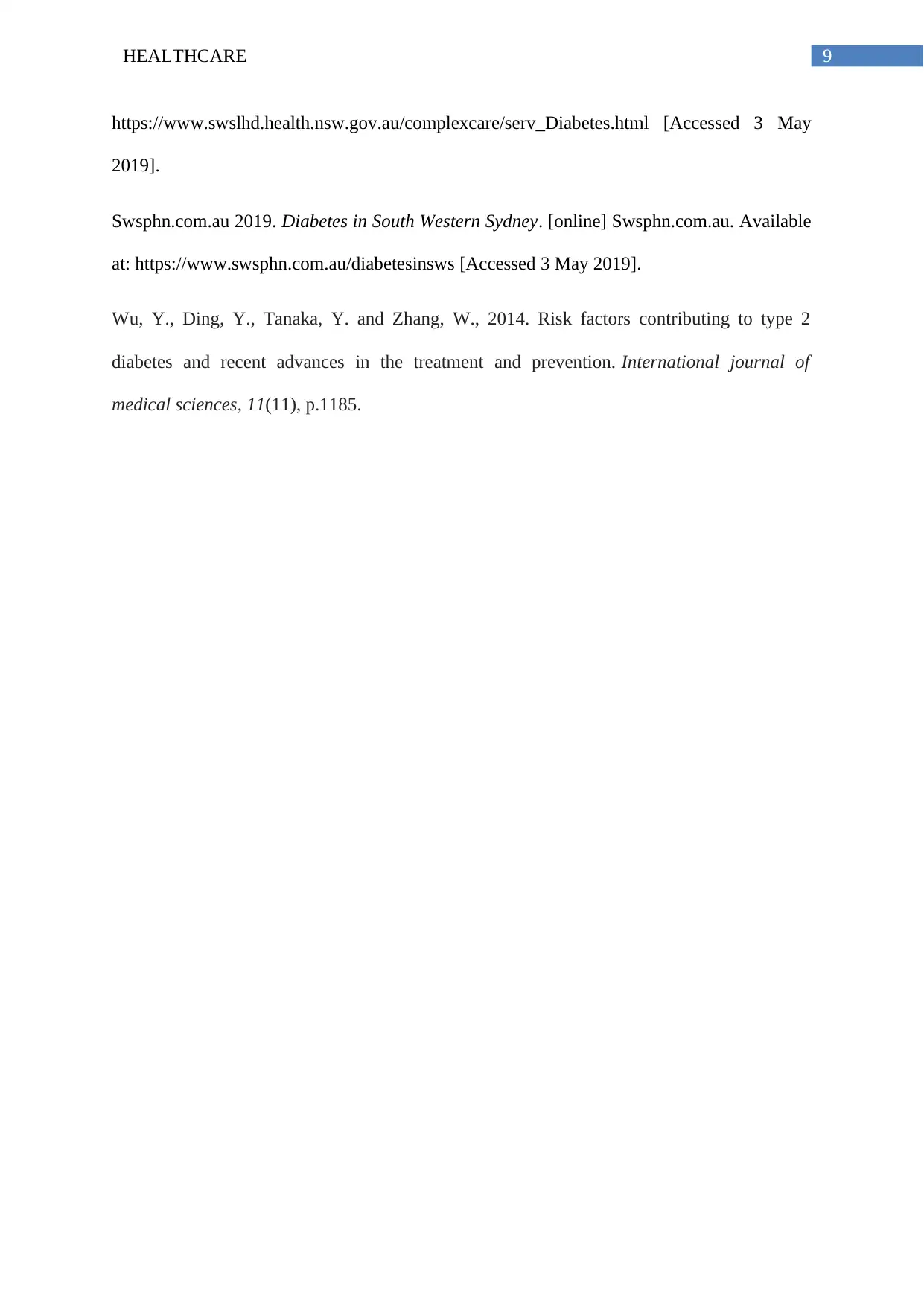
9HEALTHCARE
https://www.swslhd.health.nsw.gov.au/complexcare/serv_Diabetes.html [Accessed 3 May
2019].
Swsphn.com.au 2019. Diabetes in South Western Sydney. [online] Swsphn.com.au. Available
at: https://www.swsphn.com.au/diabetesinsws [Accessed 3 May 2019].
Wu, Y., Ding, Y., Tanaka, Y. and Zhang, W., 2014. Risk factors contributing to type 2
diabetes and recent advances in the treatment and prevention. International journal of
medical sciences, 11(11), p.1185.
https://www.swslhd.health.nsw.gov.au/complexcare/serv_Diabetes.html [Accessed 3 May
2019].
Swsphn.com.au 2019. Diabetes in South Western Sydney. [online] Swsphn.com.au. Available
at: https://www.swsphn.com.au/diabetesinsws [Accessed 3 May 2019].
Wu, Y., Ding, Y., Tanaka, Y. and Zhang, W., 2014. Risk factors contributing to type 2
diabetes and recent advances in the treatment and prevention. International journal of
medical sciences, 11(11), p.1185.
1 out of 10
Related Documents
Your All-in-One AI-Powered Toolkit for Academic Success.
+13062052269
info@desklib.com
Available 24*7 on WhatsApp / Email
![[object Object]](/_next/static/media/star-bottom.7253800d.svg)
Unlock your academic potential
Copyright © 2020–2025 A2Z Services. All Rights Reserved. Developed and managed by ZUCOL.





